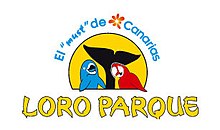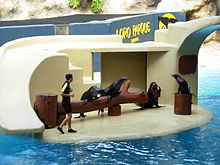
Spix's macaw, also known as the little blue macaw, is a macaw species that was endemic to Brazil. It is a member of tribe Arini in the subfamily Arinae, part of the family Psittacidae. It was first described by German naturalist Georg Marcgrave, when he was working in the State of Pernambuco, Brazil in 1638 and it is named for German naturalist Johann Baptist von Spix, who collected a specimen in 1819 on the bank of the Rio São Francisco in northeast Bahia in Brazil. This bird has been completely extirpated from its natural range, and following a several-year survey, the IUCN officially declared it extinct in the wild in 2019. However, after over 20 years of conservation efforts, 200 macaws have been bred from just two parent birds, and 52 individual birds have since been reintroduced into their natural environment in June 2022.

A companion parrot is a parrot kept as a pet that interacts abundantly with its human counterpart. Generally, most species of parrot can make excellent companions, but must be carefully managed around other common pet species like dogs and cats as they might be hostile towards them.
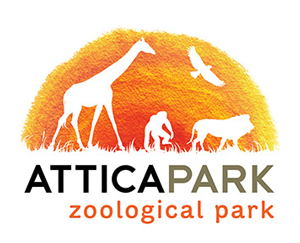
Attica Park, officially Attica Zoological Park (AZP), is a private zoo located in the suburb of Spata, approximately 20 kilometres (12 mi) east of Athens, Greece. It is the only zoo in Greece. The zoo is home to more than 1,500 animals representing 220 species, in an area of 20-hectares. It is open 365 days a year.
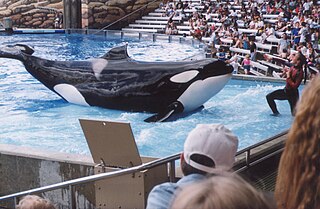
Katina is a female orca who lives at SeaWorld Orlando in Florida. She was captured off Iceland at approximately three years of age on October 26, 1978. She is the most successful breeding female orca in captivity.
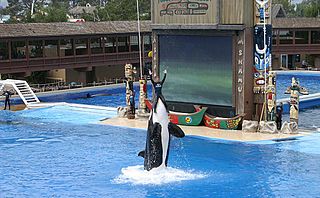
Kasatka was a wild caught female orca who lived at SeaWorld San Diego.
Ramu III was an Orca who resided at the now-defunct Windsor Safari Park in Berkshire, England between 1970 and 1976, and later, at SeaWorld San Diego in California between 1976 and 1986. An adult male, Ramu was caught on August 8, 1970, after his pod of eighty orcas was 'corralled' during the Penn Cove capture in Penn Cove, near Coupeville, Washington, United States. At capture, Ramu was 13.32 ft long and a member of the Southern Resident Killer Whales' L-pod. It is assumed his family members still survive in the Salish Sea and in nearby Pacific coastal waters.

The horned parakeet is a species of parrot in the genus Eunymphicus, in the family Psittaculidae. It is a medium-sized parrot endemic to New Caledonia. It is called "horned" because it has two black feathers that protrude from the head and have red tips.

A feral parrot is a parrot that has adapted to life in an ecosystem to which it is not native. The birds are often descended from pets that have escaped or been deliberately released. Many species of parrots are highly social, and like to gather in large flocks. Not all feral parrots are able to adapt to life outside of captivity, although having a pre-existing nearby parrot colony can assist with the adaptation process.
Orcas are large, powerful aquatic apex predators. There have been multiple orca attacks on humans in the wild, but such attacks are less common than those by captive orcas. In captivity, there have been several non-fatal and four fatal attacks on humans since the 1970s. Experts are divided as to whether the injuries and deaths were accidental or deliberate attempts to cause harm.
Tony Silva, also known as Antonio H. Silva is an American aviculturist and ornithologist, and the author of books and articles about parrots. From 1989 to 1992, he was curator of birds at Loro Parque, the largest parrot park in the world. In 1996, he was convicted of conspiring to smuggle rare parrots into the United States and of tax evasion.
Birds International Incorporated or BII is a company working in the field of aviculture established in 1975 by Antonio de Dios. It is located in Quezon City near Manila, the capital of the Philippines.

Tasmania Zoo is a zoo located in Launceston, in the Australian state of Tasmania. Situated on 900 acres (360 ha) of old growth native bushland, it is home to the state's largest collection of native and exotic animals. Tasmania Zoo is a fully accredited member of the Zoo and Aquarium Association, working closely with all Australasian zoos, and are involved in various species management programs.

Parrots (Psittaciformes), also known as psittacines, are birds with a strong curved beak, upright stance, and clawed feet. They are conformed by four families that contain roughly 410 species in 101 genera, found mostly in tropical and subtropical regions. The four families are the Psittaculidae, Psittacidae, Cacatuoidea (cockatoos), and Strigopidae. One-third of all parrot species are threatened by extinction, with a higher aggregate extinction risk than any other comparable bird group. Parrots have a generally pantropical distribution with several species inhabiting temperate regions as well. The greatest diversity of parrots is in South America and Australasia.
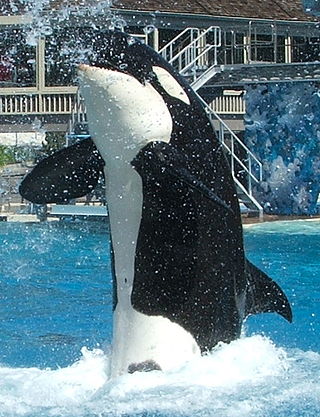
Dozens of orcas are held in captivity for breeding or performance purposes. The practice of capturing and displaying orcas in exhibitions began in the 1960s, and they soon became popular attractions at public aquariums and aquatic theme parks due to their intelligence, trainability, striking appearance, playfulness, and sheer size. As of 1 January 2024, around 59 orcas are in captivity worldwide, 35 of which were captive-born. At that time, there were 18 orcas in the SeaWorld parks.

Morgan is a female orca who was rescued in the Wadden Sea, off the northwestern coast of the Netherlands in June 2010. She was found in an unhealthy condition, severely underweight and malnourished. She lived several months at the Dolfinarium Harderwijk in the Netherlands. After it became clear that the basin at Dolfinarium was too small, multiple options were considered, including releasing Morgan and transferring her to another facility. Over a year later, after litigation and debate between scientists, a Dutch court ruled that she was to be moved. Morgan was transported to the Loro Parque in Spain in November 2011.

Dolfinarium Harderwijk, better known as the Dolfinarium, is a marine mammal park in Harderwijk, the Netherlands. It is the largest marine mammal park in Europe. Visitor numbers were steady from 2005 to 2011, numbering between 700,000 and 800,000, with only the opening of new attractions responsible for a surge in numbers. In 2012 the Dolfinarium made €12 million in sales, which was around €2,4 million lower than the year before. This was mainly due to a decline in visitor numbers because of orca Morgan leaving the park, and the park temporarily closing down due to the start of construction at the end of the year.
The American Federation of Aviculture, Inc. (AFA) is a national organization dedicated to aviculture, whose purpose is to educate the public and assist members regarding best practices for keeping and living with exotic birds. Local affiliate bird clubs throughout the United States, including Puerto Rico, along with national and international specialty organizations; comprise the Federation. The American Federation of Aviculture is registered as a non-profit 501(c)3 educational organization, with a business office located in Austin, Texas.
Alexis Martínez was a Spanish animal trainer, notable as the victim of a fatal attack by an orca. He was killed by a SeaWorld-owned orca, Keto, held at Loro Parque's Orca Ocean in the Canary Islands.
Ranger Red's Zoo & Conservation Park, formerly Peel Zoo, is a zoo and wildlife sanctuary located on the banks of the Murray River in Pinjarra, Western Australia. It is a member of the Zoo and Aquarium Association.
